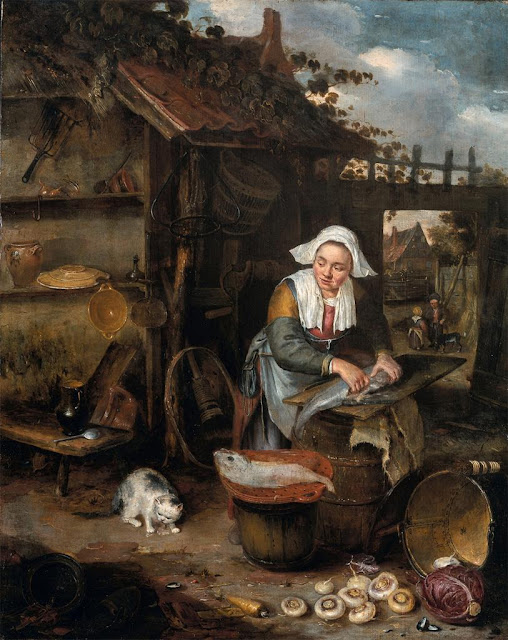I can't get over seeing this Matisse painting last winter in New York. I mentioned it a few posts ago while writing about seaweed. This is Matisse on the Normandy coast in 1920. I had always associated this period of his career with the Riviera-- especially those beautiful, escapist interiors in Nice, filled with flappers playing odalisque in front of his fantastic collection of textiles, chinoiserie and Moroccan screens ( I was in Nice for a few days when I was traveling by train at age 19, with my slightly punk haircut and my backpack, feeling a bit nefarious in such a glamorous place). But this is Etretat: a Normandy beach almost synonymous with Monet, who repeatedly returned to paint these famous pierced cliffs, especially in the 1880s (this is explored at length in the Met's catalog).
Monet was not the first-- Courbet was there in the 1860s, joined by his American pal Whistler and his gorgeous Irish girlfriend Joanna Hiffernan. Matisse had Monet's color and Courbet's sensuality in mind when he painted a series of images of dead fish on the rocky strand.
Looking closely at the image, it's really odd: there is an assemblage of fish and shellfish on a bed of seaweed: a green langoustine and an eel are the easiest to spot. Like most of Monet's later paintings, Matisse's fish painting eschews
the messy human uses of the beach, presenting only a fish still life,
leaved up out of the water onto a neat mat of seaweed. Part landscape,
part still-life, this is an image of the intertidal zone-- where flint
rocks, fallen from the limestone cliffs, form the beach, and where the
sea rises and falls, leaving seaweed and other deposits on the beach
with one tide, and whisking them back with another.
 As Robert Herbert's excellent book on Monet showed, this beach, so often painted as an empty, sublime expanse, was right in front of a busy boardwalk that was up against a town packed with hotels, casinos, summer villas, restaurants and shops.
As Robert Herbert's excellent book on Monet showed, this beach, so often painted as an empty, sublime expanse, was right in front of a busy boardwalk that was up against a town packed with hotels, casinos, summer villas, restaurants and shops.  Summer tourists, fishermen, boats, laundresses washing tourists' clothing and hotel linens all vied for space on the beach. At this point, as John Gillis points out, the boardwalk divided the people who worked on the beach (and their boats, seaweed, fish, etc) from those who were at the beach.
Summer tourists, fishermen, boats, laundresses washing tourists' clothing and hotel linens all vied for space on the beach. At this point, as John Gillis points out, the boardwalk divided the people who worked on the beach (and their boats, seaweed, fish, etc) from those who were at the beach.
But, in this painting, Matisse's beach is covered in fish. The human life is absent.
Thinking about the oddity of dead fish as "actors" in a landscape, or as features of a landscape, I remembered a very strange Dutch painting that I had seen in New Orleans over a year ago.
This is a collaborative painting (one of many of this type), by Willem Ormea (-1673) and Abraham Willaerts (1577-1664). Ormea, a still-life painter, did the fish and Willaerts, a marine painter, the landscape. The Dutch were quite proud of their maritime prowess, as well as their mastery of nature in reclaiming so much of their watery landscape for agriculture. Ormea and Willaerts produced many dead fish landscapes-- a quick search found the examples below. These paintings all seem to bring together a spectacular harvest of the sea with the industriousness of a worked coastline. Many of the fish poses and types repeat: the contorted bodies, the open mouths, the shiny rigor mortis. They seem impossibly large, beached and blotting out the beach. Close up and huge they dwarf the human activity in the middle ground and distance.
Of course, there are many examples of fish in still life paintings: Chardin comes to mind in particular, and the many great market paintings of the northern painters like Snyders and Aertsen.
 |
| Chardin |
 |
| Frans Snyders, Fish Market, 1618 |
 |
| Van Valckenborch, Fish Market, early 17the century |
 |
| Hendrik Potuyl, Housewife in an inner Courtyard Cleaning Fish, 1639-1649 |
In the 1860s and 70s, Bazille and Manet produced some of the most seductive images of fish, hearkening back to the Dutch masters:
And Manet also made some lovely sketches of fishermen working on the coast at Boulogne-sur-mer.
Van Gogh painted several still lifes of fish and crabs. By chance, I saw both of the crab paintings within a few days of each other on a trip to both London and Amsterdam.
 |
| Van Gogh, Two Crabs, 1889, National Gallery, London |
Gauguin, in his Impressionist period, made an awkward stab at a dead-fish in a landscape painting (pillaging a bit from Courbet, Manet and Cézanne all at once).
 |
| Paul Gauguin, Still Life with Jug and Red Mullet, c. 1876 |
But in spite of this artistic lineage and dialogue, this remains undeniably strange: I cannot but imagine the viscosity, the flies, the temporal presence of the slippery fish, the approaching tide and the brown seaweed.
Here are some more images from Matisse's 1920 stay in Etretat (he showed 31 paintings from his summer in Etretat in October of 1920, and they sold like hotcakes)
















.jpg)










Terrific fish folio. I wonder what the reactions would be to an exhibition with all of those images??? Caroline
ReplyDelete